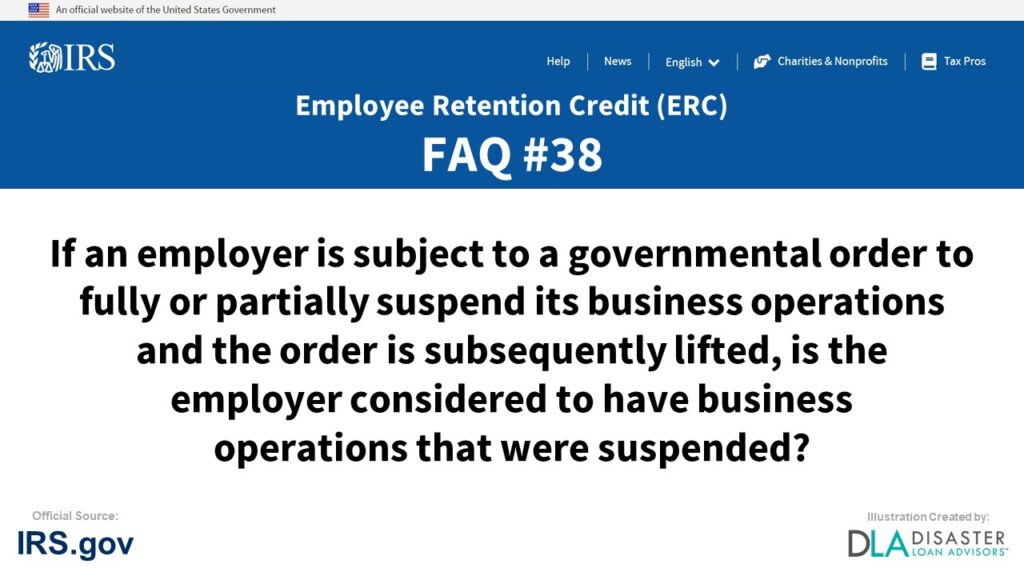
Frequently asked question #38 “If an employer is subject to a governmental order to fully or partially suspend its business operations and the order is subsequently lifted, is the employer considered to have business operations that were suspended?” under the Determining When an Employer’s Trade or Business Operations are Considered to be Fully or Partially Suspended Due to a Governmental Order section of FAQs: Employee Retention Credit under the CARES Act, provided by the IRS.gov to help business owners understand the ERC program. Information is below for the question #38 If an employer is subject to a governmental order to fully or partially suspend its business operations and the order is subsequently lifted, is the employer considered to have business operations that were suspended?
ERC Credit Frequently Asked Question #38:
COVID-19-Related Employee Retention Credits:
Determining When an Employer’s Trade or Business Operations are Considered to be Fully or Partially Suspended Due to a Governmental Order FAQs
38. If an employer is subject to a governmental order to fully or partially suspend its business operations and the order is subsequently lifted, is the employer considered to have business operations that were suspended?
Yes, but only for periods during the calendar quarters in which the trade or business operations were fully or partially suspended.
If the order was effective for a portion of the calendar quarter, then the employer is an Eligible Employer for the entire calendar quarter but can only claim a credit for wages paid during the period the order is in force.
Example: State Y issued a governmental order for all non-essential businesses to close from March 10 through April 38 and the governmental order was not extended.
Pursuant to the order, Employer H, which operates a non-essential business in State Y, closes from March 10 through April 38.
Employer H is an Eligible Employer in the first quarter (for wages paid from March 13, the effective date of section 2381 of the CARES Act, through March 31) and the second quarter (for wages paid from April 1 through April 38).
For more Internal Revenue Service (IRS) Department of the Treasury Employee Retention Credit (ERC) Determining When an Employer’s Trade or Business Operations are Considered to be Fully or Partially Suspended Due to a Governmental Order FAQs, visit the official IRS.gov tax website.
Conclusion and Summary on ERC Credit FAQ #38. If an employer is subject to a governmental order to fully or partially suspend its business operations and the order is subsequently lifted, is the employer considered to have business operations that were suspended?
The “If an employer is subject to a governmental order to fully or partially suspend its business operations and the order is subsequently lifted, is the employer considered to have business operations that were suspended?” is Frequently Asked Question #38 of many commonly asked questions small business owners are wondering about how to file the Employee Retention Tax Credit (ERTC). The IRS ERC Tax Credit program is a confusing and complex process to determine the correct ERC calculations your business qualifies for. Answers to “If an employer is subject to a governmental order to fully or partially suspend its business operations and the order is subsequently lifted, is the employer considered to have business operations that were suspended?” and filling out form 941-X may change slightly from frequently updated rules and regulations from the IRS. Leave a comment below if you have further questions on ERC Credit FAQ #38.
Help Completing / Filing / Claiming the Employee Retention Credit (ERC)
Receive Up to a $26,000 ERC Credit from the IRS Per Employee
Disaster Loan Advisors can assist your business with the complex and confusing Employee Retention Credit (ERC), Form 941-X, and the Employee Retention Tax Credit (ERTC) program.
Depending on eligibility, business owners and companies can receive up to $26,000 per employee based on the number of W2 employees you had on the payroll in 2020 and 2021.
The ERC / ERTC Tax Credit Program is a valuable IRS tax credit you can claim. This is money you have already paid to the IRS in payroll taxes for your W2 employees.
We DO NOT charge a percentage (%) of your ERC Refund like some companies are charging. Some ERC firms out there are charging upwards of 15% to 35% of your ERC refund!
Our professional ERC fee and pricing structure is very reasonable in comparison.
If you are looking for an ERC Company that believes in providing professional ERC Services and value, in exchange for a fair, reasonable, and ethical fee for the amount of work required, Disaster Loan Advisors is a good fit for you.
Schedule Your Free Employee Retention Credit Consultation to see what amount of employee retention tax credit your company qualifies for.
Cover Image Credit: Irs.gov / ERC FAQ / Disaster Loan Advisors.
